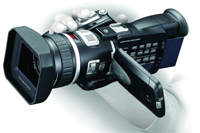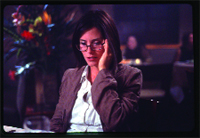
JVCs JY-HD10 was the company s entry into HDV. Expect a pro version at NAB 2005.
|
The secret to being able to record HD images using such a compact camcorder is the use of the HDV codec, which records video using an efficient long GOP MPEG-2 compression scheme. The format can be edited using Sony's Vegas 5 NLE software, Adobe's Premiere Pro and Boxx's HD [pro] HDV editing solution - all of which employ new low-cost compression technology from CineForm, (www.cineform.com/) in Carlsbad, CA. "Also, Pinnacle and Canopus can directly edit the native HDV 1080i files using a plug-in from Lumiere HD," adds Ott. "And, both Apple and Avid announced that their products will be able to edit in HD using Sony's HDV 1080i."
To edit and export Sony's native 1080i HDV format, Sony's Vegas 5 NLE software incorporates ConnectHD, a customized plug-in version of CineForm's technology that Sony sells for $149.95. During capture, ConnectHD transcodes the incoming HDV signal on the fly into CineForm's proprietary wavelet-based compression format. The resulting AVI file offers a more efficient editing configuration than HDV's native long-GOP.
Also, if users want to edit HDV in 4:3 SD, "Sony's HDV video (1440x1080-interlaced with 60i/50i switchability converts in the HVR-Z1U camcorder or within the companion VTR, the HVR-M10U for $3,700) converts to 480i or 480p video in realtime through the iLink (IEEE-1394/Firewire) output," says Ott. In addition, the user can select a squeezed, letterbox, or 4:3 cropped image to deliver through iLink to the NLE or directly to a DVCAM VTR.

|
The camcorder offers a broad range of features, like CinemaTone Gamma and color correction for film-style production; and the HVR-M10U VTR can record and playback video in HDV 1080i, DVCAM, and DV, as well as playback video in 720/30p via the component analog outputs. "This camcorder and VTR enable the user to acquire and archive in HDV, and produce a finished, high-quality SD release without making any additional investments or changes to their existing NLE or monitors. When the professional using our HDV products is ready, they can upgrade their workflow to full HD production at their own pace," notes Ott.
PANASONIC
Last year, when DP Nancy Schreiber A.S.C. was asked to shoot the independent film, November, using Panasonic's AG-DVX100 mini DV 3-CCD camcorder, she was concerned about the resolution, sharpness, and other technical limitations of DV shooting, having mainly worked with film cameras.
"After we tested it, I was impressed with its color handling, my ability to control the contrast; and shoot at 1/24th second shutter speed, which meant I could shoot inside or outside at night with much less light," says Schreiber. "The camcorder also handled highlights well, with a beautiful burn-out, and fewer artifacts than other similarly-priced cameras."
November was produced by IFC Productions and stars Courtney Cox, James Le Gros and Anne Archer. It won the Excellence in Cinematography Award at the 2004 Sundance Film Festival. After it was edited on an Avid Adrenaline and output to Digital Betacam; it was color corrected at LaserPacific by colorist Mike Sowa. The audio was finished at Skywalker Sound. The movie remained tapeless throughout post. The final master was up-converted to 1080p HD, as well as cross-converted to 1080i, which was used for projection at Sundance with good results.
Among the AG-DVX100's professional features are: F11@2000 lux sensitivity; a precision wide-angle lens with servo/manual zoom; up to seven choices of gamma settings; auto focus assist, three user-programmable buttons; and 16:9 anamorphic letterbox and digital squeeze; plus an IEEE-1394 interface. Panasonic plans to introduce the AG-DVX100A, which will add over 20 new user-requested features, including improved color reproduction, new cine-like gamma curves and enhanced image adjustments.
"In addition to shooting 480i/60 and 480p/30, the AG-DVX100 can capture images at 480p/24, but it does not record them in 24p," explains Jan C. Livingston, product line business manager for the DVX-100 product line for Panasonic (www.panasonic.com/business/) in Secaucus, NJ. "Instead, it lays those images onto videotape in the 480-interlaced format by adding one of two different 2:3 pull-down technologies that are in the camera; 2:3 or 2:3:3:2.
"In post, newer NLEs, like Final Cut Pro, Premiere, Sony Vegas, and Avid Xpress DV, are able to extract those 24 frames automatically during import and create a 24p file with which to edit on the timeline." While Avid's Adrenaline system also supports this "Advanced 24p" or 2:3:3:2 pull-down technology; legacy NLEs, such as Avid Media Composers, only support the standard pull-down, 2:3. So, producers need to think about which NLE will be used before a shooting format is selected. Livingston says, "This technology enables you to get immediate feedback during production and editing about how your film will look. And seeing that before actually committing it to film is a very big benefit."
CANON
"The Canon XL2 is unique in that it is the only Mini DV camcorder on the market to offer an XL mount interchangeable lens system," says Mitch Glick, assistant manager of product marketing for Canon's Video Division, Canon U.S.A., Inc., in Lake Success, NY (www.www.consumer.usa.canon.-com/). "Having the ability to change lenses offers professional videographers a wealth of flexibility in grabbing just the shot they want. Users are able to change lenses from the XL series of lenses - which includes a 20X zoom lens, 16X automatic lens; 16X manual lens, and 3X wide-angle lens." The XL2 also benefits from Canon's optics technology and image stabilization system.
Users can select between the 4:3 or 16:9 aspect ratio, and frame rates including 60i, 30p, 24p in standard definition. There are customizable "Cine-Look" controls which enable videographers to tweak the image and then save these individual settings (such as gamma, sharpness, skin detail, color matrix and black stretch) as custom presets that can be quickly recalled in similar situations.
Glick says, "Canon does not manufacture VTRs, however something users may find useful for professional editing is the camera's ability to generate SMPTE color bars, and a 1kHz reference tone. The camcorder can also record a SMPTE timecode on the tape with the choice of either drop, non-drop, rec-run, free-run, and user bit settings.
Glick says the XL2's high level of flexibility and precision control makes it suitable for indie filmmakers, event videographers, studios and corporate video producers.
JVC
JVC's first HDV camcorder, the JY-HD10, is a single-chip HDV camcorder, with a companion VTR, the CU-VH1, for editing. But at NAB 2005, JVC plans to introduce a new HD camcorder, designed as a professional three-chip model with more of the features that pro videographers are looking for.
The JY-HD10, priced at $3,995, has been very successful, and popular among filmmakers and television productions, including American Idol, which has been shooting with five of these. Unlike Sony, which based its HDV camcorder on 1080i, JVC has based its camcorders on the 720p format with native 16:9 widescreen. Also, unlike Sony's bit-rate, which is 25 Mbps, JVC's HD camcorder records a 19 Mbps bit-stream, matching the data rate used in digital broadcasts.
"Our philosophy with HD is that there is a lot you can do if you're recording at lower bit-rates, including transport the signal easier via satellite, microwave and the Internet," says Dave Walton, national marketing communications manager for JVC, (www.pro.jvc.com/) in Wayne, NJ. "And we're addressing this issue in our product line.
"Another workflow enhancement we're working on is integrated hard disk drive recording into our camcorders. So, when you plug into your NLE, there's no transferring, digitizing, or ingesting video. It's already in the right format and ready to edit," says Walton.
While the JY-HD10 is a prosumer-grade camcorder, "It broke the ice in a very transitional time," says Walton. "The next steps will be gigantic leaps in value and affordable HD offerings. We believe that affordable HD camcorders will ultimately exceed the popularity of DV."